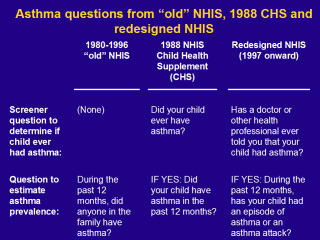| front |1 |2 |3 |4 |5 |6 |7 |8 |9 |10 |11 |12 |13 |14 |15 |16 |17 |18 |19 |20 |21 |review |
 |
The different
questions from the various NHIS survey years are shown here. The first column shows the asthma question before the 1997 redesign. There was a single question asking if anyone in the family had asthma in the past 12 months, and the estimates produced by responses to this question were called "asthma period prevalence." The last column shows the questions implemented in 1997. There is a screener to determine if a doctor or other health professional had ever diagnosed the sample child with asthma. If yes, then the parent is asked if the child had an asthma attack in the past 12 months. To be included as a "case" after 1997, a respondent must report that he or she has been diagnosed with asthma by a health professional and had at least one attack or episode of asthma in the past 12 months. Since this case definition is more specific, it is not surprising that asthma attack prevalence estimates are lower than pre-1997 asthma period prevalence estimates. But how much of the decrease is due to the change in the question versus an actual change in underlying asthma prevalence in the population? The middle column shows questions from the 1988 CHS. Half of the child sample from the standard 1988 NHIS was also asked the questions in the CHS. Therefore, there is a sample asked both the question in the first column, and the two part question in the second column that are similar, but not identical, to those in the redesigned NHIS. The difference between prevalence estimates produced by the first column and the second column can be used to measure how changing the questions in 1997 affected asthma prevalence estimates. However, this comparison will only yield a rough approximation because the 1988 CHS did not ask about receiving a diagnosis of asthma from a health professional. |